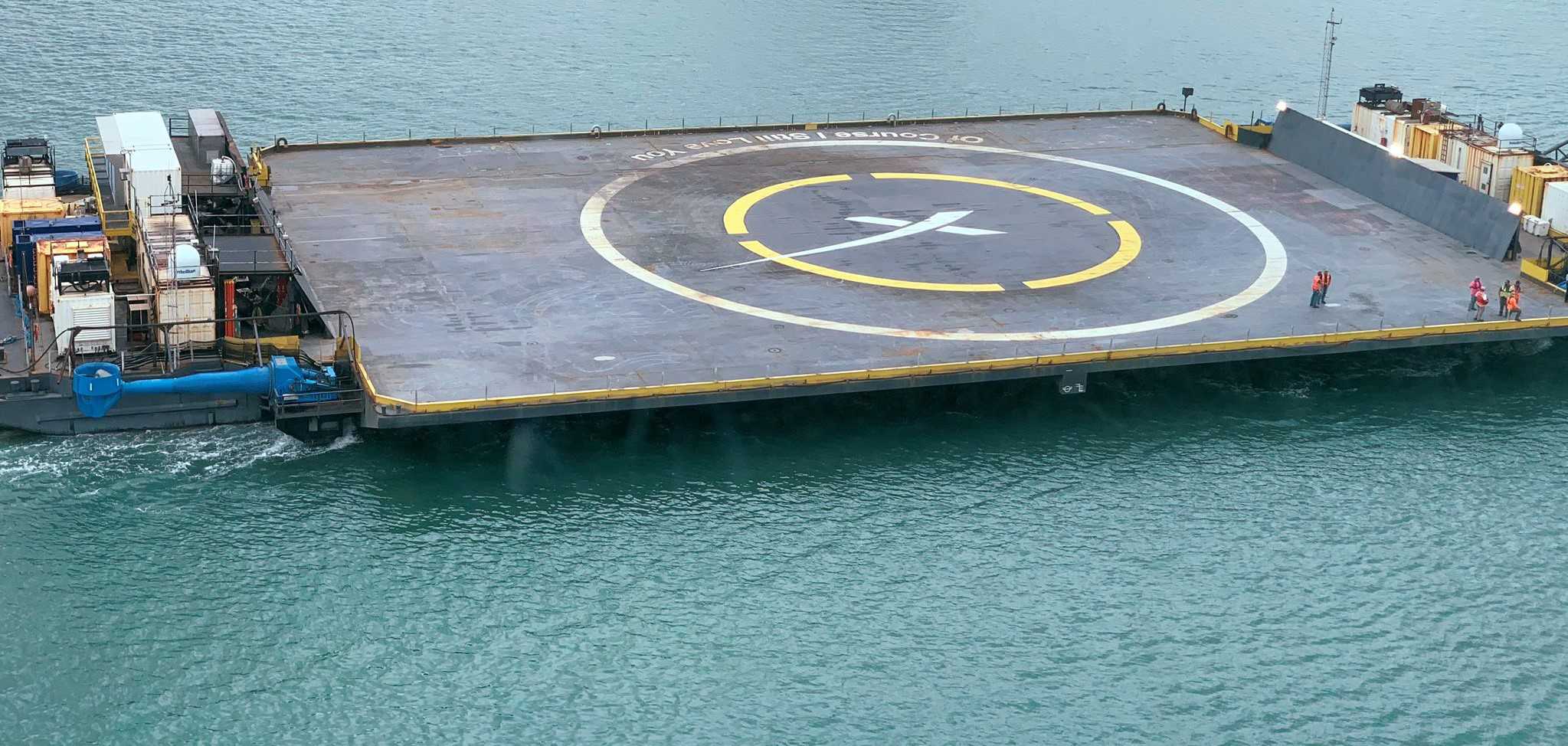
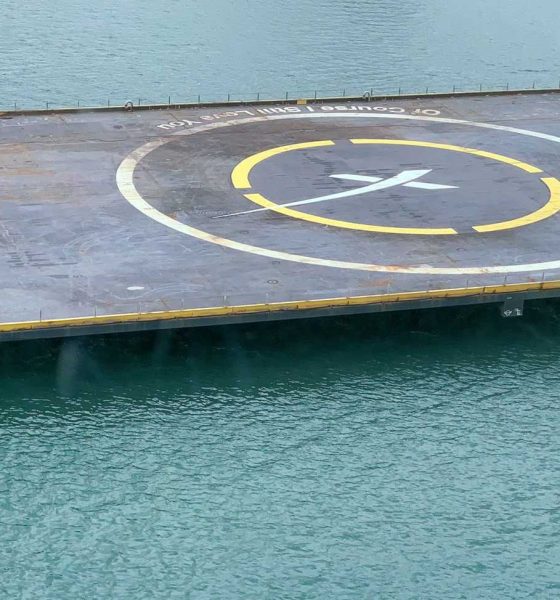
News
SpaceX rings in the New Year with preparations for first Falcon 9 launch of 2020
SpaceX’s first Falcon 9 launch of 2020 – and the new decade – is just around the corner after drone ship Of Course I Still Love You (OCISLY) departed Port Canaveral on Monday to prepare for its 27th booster landing attempt.
Known as Starlink-2, SpaceX’s first launch of the new year slipped a handful of days from December 30th to January 3rd and finally January 6th and will be the company’s second launch of 60 upgraded Starlink v1.0 satellites, as well as the third dedicated Starlink launch overall. Just one of potentially dozens of SpaceX launches planned in 2020, the year is setting up to be – by a long shot – the company’s most ambitious year ever.
Meanwhile, Starlink-2 alone is set to ring in at least two significant milestones, pushing the nascent broadband internet constellation a step closer to serving customers and Falcon 9 reusability a step closer to being fully realized.
Drone ship OCISLY departed Port Canaveral on December 30th and is now being towed some 630 km (390 mi) downrange to Falcon 9’s planned Atlantic Ocean recovery location. SpaceX’s first launch and landing of 2020 will also be the three-year-old drone ship’s 27th attempted Falcon booster recovery and – hopefully – 23rd successful recovery.
Simultaneously, SpaceX technicians are in the midst of preparing other recovery fleet assets for what appears to be a partial fairing recovery attempt. Twin fairing catchers Ms. Tree and Ms. Chief debuted on their first simultaneous fairing catch attempt in December 2019 but each unfortunately missed their catches, instead picking up the floating fairing halves off the surface of the Atlantic and returning to port on December 18th.
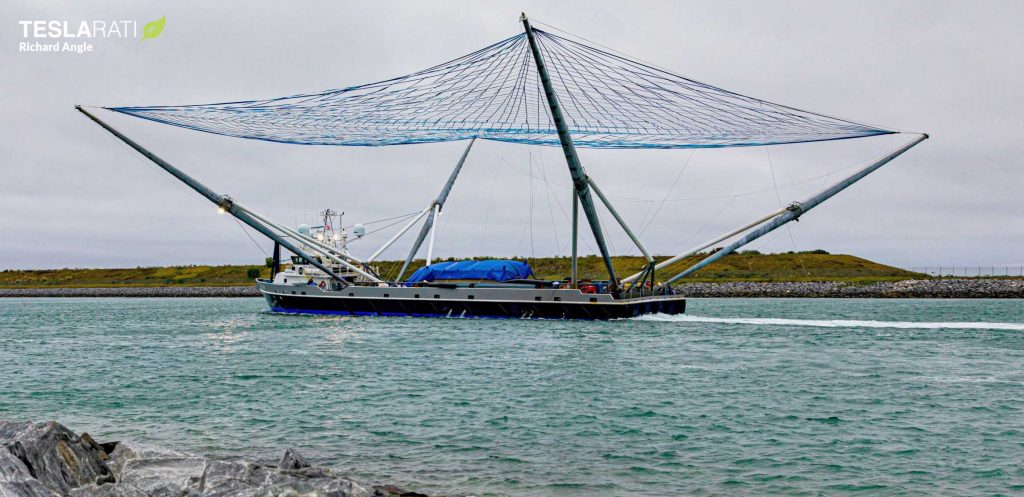
The fairing halves were thus still successfully recovered and may be able to fly again on a future Starlink mission, but both fairing recovery ships suffered damage during their first simultaneous deployment. Ms. Tree suffered minimal damage in the form of tears to its secondary net – an easy fix – but Ms. Chief was not as lucky and somehow lost one of the two white booms that support each of her four arms.
That wounded arm was visibly hanging lower than its companions when Ms. Chief returned to port and technicians have since removed all of her arms, presumably evaluating whether the ordeal overstressed any components or caused significant damage.
Unsurprisingly, Ms. Chief will reportedly not take part in the fairing recovery portion of SpaceX’s imminent Starlink-2 launch, although it’s starting to look like Ms. Tree will be able to attempt a catch. SpaceX will still attempt to extract both fairing halves from the Atlantic even if the catch attempt fails and appears to be preparing GO Navigator to recover the half that would have otherwise been assigned to Ms. Chief.
Two milestones, one launch
As implied by the Starlink-2 title, SpaceX’s first launch of 2020 will feature the third batch of 60 Starlink satellites. Excluding 9 Starlink v0.9 satellites that have been intentionally lowering their orbits over the last several months to hasten reentry, this will give SpaceX a constellation of at least 170 operational satellites less than eight months after the company began launching the satellites.
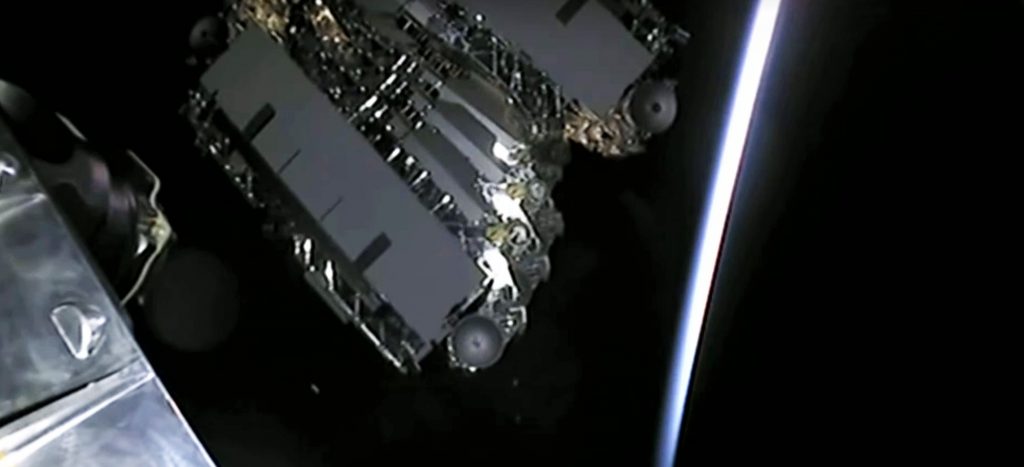
This may not immediately seem significant but 170 operational satellites in orbit could make Starlink the world’s largest satellite constellation and SpaceX the world’s largest constellation operator. The only known competitor that comes close is Planet Labs, an Earth observation company believed to have approximately 150-170 operational satellites in orbit – most of which are 5-10 kg (10-20 lb) ‘Doves’ roughly the size of a loaf of bread.
Put another way, after Starlink-2, SpaceX will have around 45 metric tons (100,000 lb) of functional Starlink satellites in orbit, a constellation mass probably only rivaled by major geostationary commsat operators, global navigation satellites, and a few other high-value military constellations.
Meanwhile, according to NASASpaceflight.com, SpaceX has assigned Falcon 9 booster B1049.3 to its Starlink-2 mission, meaning that the launch will mark the second time that a single SpaceX rocket has flown four orbital-class missions. This follows on the footsteps of the November 11th, 2019 Starlink-1 launch, which saw Falcon 9 B1048 become the first booster to fly four times.
At this point, SpaceX has two additional Starlink launches scheduled in January and has plans for as many as 38 orbital launches throughout 2020. To complete that incredibly ambitious manifest, SpaceX will have to dig deep into its fleet of reusable rockets, meaning that Falcon 9 B1049’s imminent fourth launch is almost certainly just the tip of the iceberg. Falcon 9 B1049 is scheduled to launch SpaceX’s Starlink-2 mission no earlier than (NET) 9:20 pm ET, January 6th (02:20 UTC, Jan 7).
Check out Teslarati’s Marketplace! We offer Tesla accessories, including for the Tesla Cybertruck and Tesla Model 3.

News
Ford cancels all-electric F-150 Lightning, announces $19.5 billion in charges
“Rather than spending billions more on large EVs that now have no path to profitability, we are allocating that money into higher returning areas, more trucks and van hybrids, extended range electric vehicles, affordable EVs, and entirely new opportunities like energy storage.”
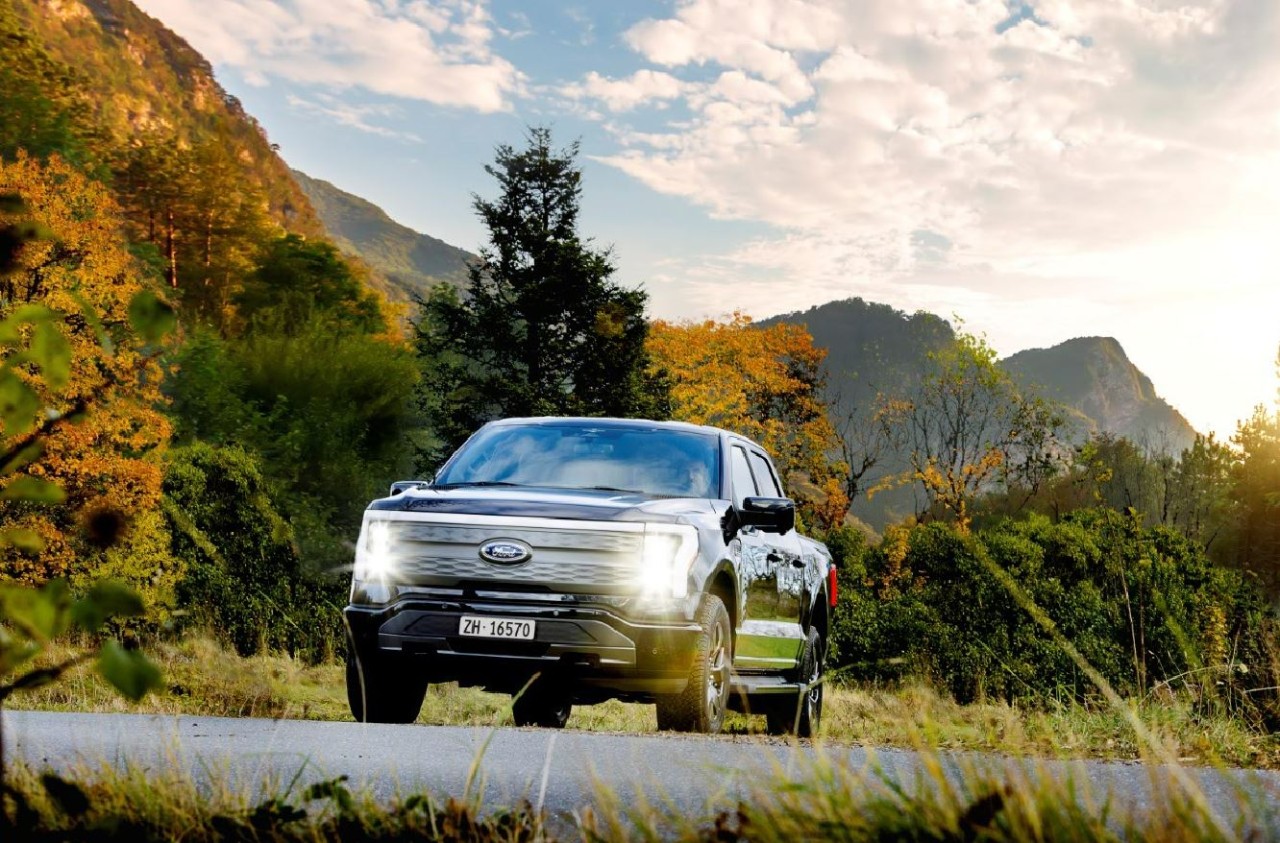
Ford is canceling the all-electric F-150 Lightning and also announced it would take a $19.5 billion charge as it aims to quickly restructure its strategy regarding electrification efforts, a massive blow for the Detroit-based company that was once one of the most gung-ho on transitioning to EVs.
The announcement comes as the writing on the wall seemed to get bolder and more identifiable. Ford was bleeding money in EVs and, although it had a lot of success with the all-electric Lightning, it is aiming to push its efforts elsewhere.
It will also restructure its entire strategy on EVs, and the Lightning is not the only vehicle getting the boot. The T3 pickup, a long-awaited vehicle that was developed in part of a skunkworks program, is also no longer in the company’s plans.
Instead of continuing on with its large EVs, it will now shift its focus to hybrids and “extended-range EVs,” which will have an onboard gasoline engine to increase traveling distance, according to the Wall Street Journal.
“Ford no longer plans to produce select larger electric vehicles where the business case has eroded due to lower-than-expected demand, high costs, and regulatory changes,” the company said in a statement.
🚨 Ford has announced it is discontinuing production of the F-150 Lightning, as it plans to report a charge of $19.5 billion in special items.
The Lightning will still be produced, but instead with a gas generator that will give it over 700 miles of range.
“Ford no longer… pic.twitter.com/ZttZ66SDHL
— TESLARATI (@Teslarati) December 15, 2025
While unfortunate, especially because the Lightning was a fantastic electric truck, Ford is ultimately a business, and a business needs to make money.
Ford has lost $13 billion on its EV business since 2023, and company executives are more than aware that they gave it plenty of time to flourish.
Andrew Frick, President of Ford, said:
“Rather than spending billions more on large EVs that now have no path to profitability, we are allocating that money into higher returning areas, more trucks and van hybrids, extended range electric vehicles, affordable EVs, and entirely new opportunities like energy storage.”
CEO Jim Farley also commented on the decision:
“Instead of plowing billions into the future knowing these large EVs will never make money, we are pivoting.”
Farley also said that the company now knows enough about the U.S. market “where we have a lot more certainty in this second inning.”
News
SpaceX shades airline for seeking contract with Amazon’s Starlink rival

SpaceX employees, including its CEO Elon Musk, shaded American Airlines on social media this past weekend due to the company’s reported talks with Amazon’s Starlink rival, Leo.
Starlink has been adopted by several airlines, including United Airlines, Qatar Airways, Hawaiian Airlines, WestJet, Air France, airBaltic, and others. It has gained notoriety as an extremely solid, dependable, and reliable option for airline travel, as traditional options frequently cause users to lose connection to the internet.
Many airlines have made the switch, while others continue to mull the options available to them. American Airlines is one of them.
A report from Bloomberg indicates the airline is thinking of going with a Starlink rival owned by Amazon, called Leo. It was previously referred to as Project Kuiper.
American CEO Robert Isom said (via Bloomberg):
“While there’s Starlink, there are other low-Earth-orbit satellite opportunities that we can look at. We’re making sure that American is going to have what our customers need.”
Isom also said American has been in touch with Amazon about installing Leo on its aircraft, but he would not reveal the status of any discussions with the company.
The report caught the attention of Michael Nicolls, the Vice President of Starlink Engineering at SpaceX, who said:
“Only fly on airlines with good connectivity… and only one source of good connectivity at the moment…”
CEO Elon Musk replied to Nicolls by stating that American Airlines risks losing “a lot of customers if their connectivity solution fails.”
American Airlines will lose a lot of customers if their connectivity solution fails
— Elon Musk (@elonmusk) December 14, 2025
There are over 8,000 Starlink satellites in orbit currently, offering internet coverage in over 150 countries and territories globally. SpaceX expands its array of satellites nearly every week with launches from California and Florida, aiming to offer internet access to everyone across the globe.
Currently, the company is focusing on expanding into new markets, such as Africa and Asia.
News
Tesla Model Y Standard stuns in new range test, besting its Premium siblings
Tesla’s newer vehicles have continued to meet or exceed their EPA estimates. This is a drastic change, as every 2018-2023 model year Tesla that Edmunds assessed did not meet its range estimates.

The Tesla Model Y Standard stunned in a new range test performed by automotive media outlet Edmunds, besting all of its Premium siblings that are more expensive and more luxurious in terms of features.
Testing showed the Model Y Standard exceeded its EPA-estimated range rating of 321 miles, as Edmunds said it is the “longest-range Model Y that we’ve ever put on our loop.” In the past, some vehicles have come up short in comparison with EPA ranges; for example, the Model Y’s previous generation vehicle had an EPA-estimated range of 330 miles, but only drove 310.
Additionally, the Launch Series Model Y, the first configuration to be built in the “Juniper” program, landed perfectly on the EPA’s range estimates at 327 miles.
It was also more efficient than Premium offerings, as it utilized just 22.8 kWh to go 100 miles. The Launch Series used 26.8 kWh to travel the same distance.
It is tested using Edmunds’ traditional EV range testing procedure, which follows a strict route of 60 percent city and 40 percent highway driving. The average speed throughout the trip is 40 MPH, and the car is required to stay within 5 MPH of all posted speed limits.
Each car is also put in its most efficient drive setting, and the climate is kept on auto at 72 degrees.
“All of this most accurately represents the real-world driving that owners do day to day,” the publication says.
With this procedure, testing is as consistent as it can get. Of course, there are other factors, like temperature and traffic density. However, one thing is important to note: Tesla’s newer vehicles have continued to meet or exceed their EPA estimates. This is a drastic change, as every 2018-2023 model year Tesla that Edmunds assessed did not meet its range estimates.
Tesla Model Y Standard vs. Tesla Model Y Premium
Tesla’s two Model Y levels both offer a great option for whichever fits your budget. However, when you sit in both cars, you will notice distinct differences between them.
The Premium definitely has a more luxurious feel, while the Standard is stripped of many of the more premium features, like Vegan Leather Interior, acoustic-lined glass, and a better sound system.
You can read our full review of the Model Y Standard below:
Tesla Model Y Standard Full Review: Is it worth the lower price?








